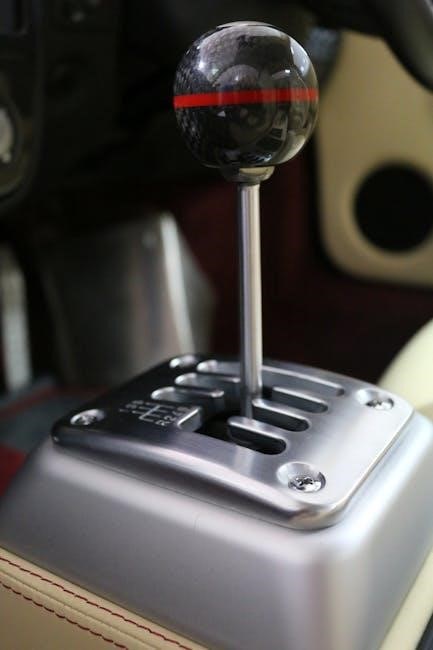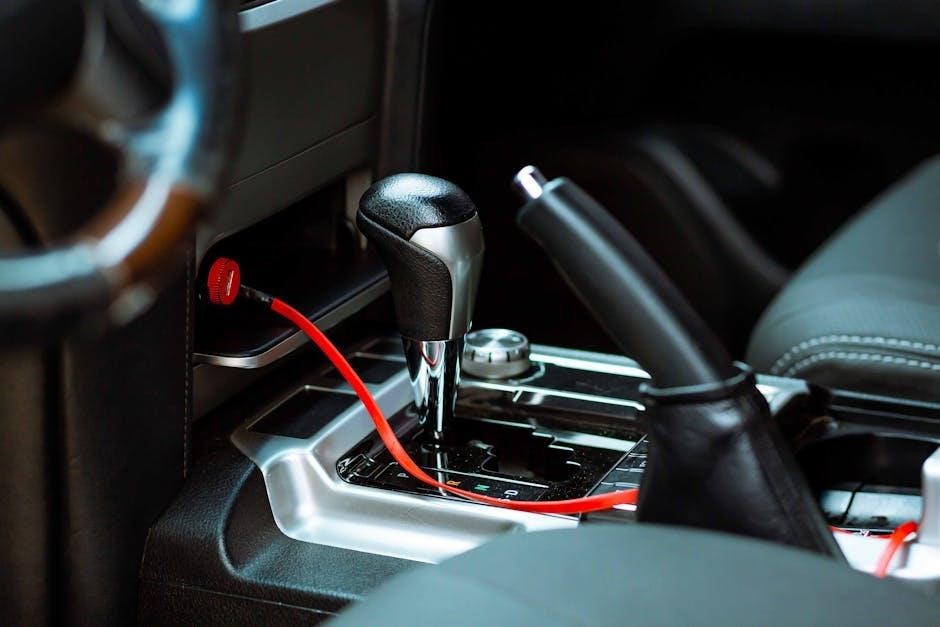Toyota manual transmission fluid is specifically designed to lubricate and protect gears in manual transmissions, ensuring smooth operation and longevity. It meets API GL-4 specifications with a viscosity of 75W-90, providing optimal performance and protection for synchromesh mechanisms. Regular maintenance with the correct fluid is essential for maintaining transmission health and preventing premature wear. Proper fluid selection ensures consistent gear engagement and disengagement, while incorrect fluids can lead to mechanical issues. Toyota recommends using genuine or synthetic oils that meet these standards to maintain reliability and durability. Always refer to the owner’s manual or manufacturer guidelines for the correct fluid type and viscosity to ensure optimal transmission performance and extend the life of your vehicle’s manual transmission system.
Overview of Manual Transmissions in Toyota Vehicles
Toyota manual transmissions are designed for smooth shifting and durability, offering precise control over gear changes. These transmissions use gear oil rather than automatic transmission fluid (ATF), requiring specific viscosities like 75W-90 to maintain optimal performance. The synchromesh mechanism in Toyota manuals relies on low-viscosity fluids to reduce wear and ensure smooth engagement. Regular maintenance with the correct fluid is crucial to prevent premature wear and maintain the transmission’s reliability. Toyota manual transmissions are known for their robust design and are featured in models like the Tacoma, 86, and GR Corolla, catering to both everyday drivers and enthusiasts seeking a hands-on driving experience.
Importance of Transmission Fluid in Manual Transmissions
Transmission fluid is vital for lubricating gears and bearings in manual transmissions, preventing wear and overheating. It ensures smooth gear engagement and disengagement by maintaining proper friction levels. Without adequate lubrication, components can overheat and fail, leading to costly repairs. Regular fluid checks and changes are essential to maintain optimal performance and extend the lifespan of the transmission. Correct fluid viscosity, such as 75W-90, ensures compatibility with the transmission’s design, providing consistent operation under various driving conditions and protecting the synchromesh mechanism from premature degradation.
Understanding Toyota Manual Transmission Fluid
Toyota manual transmission fluid is a high-performance synthetic oil designed for manual transmissions, ensuring optimal gear lubrication and protection. It meets API GL-4 specifications with a 75W-90 viscosity, providing excellent wear resistance and smooth gear operation.
Types of Transmission Fluids for Toyota Manual Transmissions
Toyota manual transmissions use specific gear oils to ensure optimal performance. The most common type is the Toyota Genuine Manual Transmission Gear Oil, which meets API GL-4 specifications with a 75W-90 viscosity. Synthetic oils like Redline MT90 and Ravenol VSG 75W-90 are also popular alternatives, offering superior lubrication and wear protection. These fluids are designed to maintain smooth gear engagement and prevent overheating. Always use oils that meet Toyota’s recommended specifications to ensure compatibility and longevity of the transmission system.
Viscosity and API Specifications for Toyota Manual Transmissions
Toyota manual transmissions require fluids with a viscosity of 75W-90 and API GL-4 specifications. This viscosity ensures proper lubrication across a wide temperature range, while GL-4 certification guarantees protection against wear, corrosion, and scoring of gear teeth. Using fluids with incorrect viscosity or API ratings, such as 80W-90 or GL-5, can lead to poor shifting, overheating, or premature wear. Always adhere to Toyota’s recommendations to maintain optimal performance and extend the life of the transmission.

How to Check Toyota Manual Transmission Fluid
Locate the transmission fluid dipstick, typically found near the gearshift or under the hood. Pull it out, wipe it clean, and reinsert to check the level. Ensure the car is on level ground and the engine is warm for accuracy. The dipstick will indicate the fluid level, which should be between the minimum and maximum marks. Check the fluid’s color and consistency; it should be light amber and free of debris. If low, add the recommended 75W-90 API GL-4 fluid. Consult the owner’s manual for specific instructions and maintenance intervals to ensure optimal transmission health.
Locating the Transmission Fluid Dipstick
The transmission fluid dipstick is usually positioned near the gearshift or under the hood, depending on the Toyota model. For most manual transmissions, it is labeled clearly or marked with a gear icon. Ensure the vehicle is parked on a level surface and the engine is turned off or warmed up, as specified in the owner’s manual. Open the hood and visually inspect the area around the transmission compartment. The dipstick may be attached to the transmission housing or connected to the gearshift mechanism. Always consult the vehicle’s manual for precise location details to avoid confusion with other fluid reservoirs.
Proper Procedure for Checking Fluid Levels
Park the vehicle on a level surface and turn off the engine. Allow it to cool slightly to ensure accurate fluid level reading. Locate the transmission fluid dipstick, pull it out, and wipe it clean with a lint-free cloth. Insert the dipstick back into the transmission and pull it out again to check the fluid level. The level should be between the “MIN” and “MAX” marks on the dipstick. If the fluid is below the minimum, topping up may be necessary. Also, inspect the fluid’s color and consistency for signs of contamination or degradation.
How to Top Up Toyota Manual Transmission Fluid
Ensure the vehicle is on a level surface. Locate the transmission filler plug, remove it, and use a funnel to add the recommended fluid slowly. Replace the plug and check the level with the dipstick to avoid overfilling.
Recommended Fluid for Topping Up
For topping up Toyota manual transmission fluid, use Toyota Genuine Manual Transmission Gear Oil or equivalent synthetic fluids meeting API GL-4 specifications with a viscosity of 75W-90. This ensures optimal lubrication, wear protection, and smooth gear shifting. Avoid using non-synthetic or incorrect viscosity oils, as they may damage the transmission. Always check the owner’s manual or manufacturer guidelines for confirmation. Compatible alternatives include Redline MT90 or Ravenol VSG 75W-90, but ensure they meet Toyota’s specifications for your specific vehicle model.
Step-by-Step Guide for Adding Fluid
Locate the transmission fluid dipstick under the hood, as indicated in your Toyota’s manual.
Pull out the dipstick and wipe it clean with a lint-free cloth.
Insert the dipstick back and pull it out again to check the current fluid level.
Pour the recommended Toyota Genuine Manual Transmission Gear Oil (75W-90) slowly into the reservoir.
Recheck the fluid level by reinserting the dipstick.
Add more fluid if necessary, ensuring not to overfill beyond the “MAX” mark.
Replace the dipstick securely and start the engine to circulate the new fluid.
Turn off the engine and verify the fluid level one last time.
Dispose of used materials responsibly. Always follow safety precautions and refer to your owner’s manual for specific instructions.

Changing Toyota Manual Transmission Fluid
Changing Toyota manual transmission fluid involves draining the old fluid, inspecting for contamination, and refilling with Toyota Genuine Manual Transmission Gear Oil. Use a drain pan and rags for a clean process. Ensure the vehicle is on level ground and warm the engine before draining. Always follow Toyota’s guidelines for fluid capacity and type to maintain optimal performance and prevent damage.
Preparation and Tools Needed
To change Toyota manual transmission fluid, you’ll need a drain pan, socket wrench, rags, safety goggles, and new fluid. Warm the engine, ensure the car is on level ground, and wear protective gear. Locate the transmission drain plug, typically at the bottom of the transmission pan. Use a torque wrench to avoid stripping bolts. Have Toyota Genuine Manual Transmission Gear Oil (75W-90, API GL-4) ready. Refer to the owner’s manual for specific tools and fluid capacity. Proper preparation ensures a clean and efficient fluid change process.
Draining and Refilling the Fluid
Position the drain pan under the transmission and remove the drain plug using a socket wrench. Allow the fluid to drain completely before replacing the plug. Refill with Toyota Genuine Manual Transmission Gear Oil (75W-90, API GL-4), following the recommended capacity from the owner’s manual. Replace the filler plug and check the fluid level using the dipstick. Wipe any spills with rags to prevent contamination. Ensure the car is on level ground during this process for accurate fluid level measurement and to avoid overfilling, which can damage the transmission. Proper refilling ensures optimal lubrication and performance.

Signs That Toyota Manual Transmission Fluid Needs Changing
Visible contamination, darkened fluid, or a burnt smell indicate degradation. Grinding noises, difficulty shifting gears, or slipping gears signal worn fluid. Regular checks prevent severe damage.
Visible Contamination or Discoloration
Transmission fluid contamination or discoloration is a clear sign it needs changing. Over time, dirt, moisture, or metal shavings can mix with the fluid, reducing its effectiveness. Discoloration, such as darkening or blackening, indicates degradation or contamination. Milky patches may appear if water enters the system. These issues can lead to poor lubrication, causing gear wear and potential failure. Always inspect the fluid’s appearance during regular checks and address any abnormalities promptly to maintain optimal transmission performance and prevent costly repairs.
Abnormal Noises or Performance Issues
Abnormal noises, such as grinding, whining, or clunking, often indicate issues with the manual transmission fluid. These sounds can signal poor lubrication, worn gears, or debris in the fluid. Performance issues like difficulty shifting gears or slipping between gears may also arise from degraded or insufficient fluid. Using the wrong fluid type or failing to change it regularly can exacerbate these problems. Addressing these symptoms promptly by checking and replacing the fluid can prevent further damage and ensure smooth transmission operation. Always use Toyota-recommended fluids to maintain optimal performance and avoid costly repairs.

Troubleshooting Common Issues with Toyota Manual Transmission Fluid
Troubleshooting Toyota manual transmission fluid issues involves identifying symptoms like leaks or contamination, checking fluid levels, and ensuring the correct API GL-4 fluid is used. Consult professionals if problems persist.
Leakages and Their Causes
Leaks in Toyota manual transmissions often stem from worn seals, damaged gaskets, or cracks in the transmission pan. Over time, seals can deteriorate due to heat or mileage. Improper installation of pans or plugs may also cause leaks. Additionally, overfilling the transmission can lead to fluid escaping through seals. Regular inspections of seals and gaskets are crucial to prevent fluid loss. Addressing leaks promptly is essential to avoid further damage or contamination, which can lead to costly repairs.
Incorrect Fluid Usage and Its Effects
Using the wrong fluid in a Toyota manual transmission can lead to severe damage, including gear wear and synchromesh failure. Incorrect viscosity or API specifications may cause inconsistent gear engagement and increased wear. Over time, sludge buildup can occur, reducing transmission efficiency and potentially leading to costly repairs. Always use Toyota-recommended SAE 75W-90/API GL-4 fluid to ensure proper lubrication and performance. Incorrect fluid usage can void warranties and necessitate premature transmission overhauls, emphasizing the importance of adhering to manufacturer guidelines for optimal functionality and longevity.
Best Brands for Toyota Manual Transmission Fluid
Toyota Genuine Manual Transmission Gear Oil is the top choice for reliability and performance. Synthetic options like Redline MT90 and Ravenol VSG 75W-90 are also highly recommended for durability and smooth shifting.
Toyota Genuine Manual Transmission Gear Oil
Toyota Genuine Manual Transmission Gear Oil is specifically formulated for optimal performance in Toyota manual transmissions. It meets the required API GL-4 specifications with a viscosity of 75W-90, ensuring smooth gear engagement and protection against wear. This oil is designed to maintain the synchromesh mechanism’s efficiency and prevent premature corrosion or damage. Its synthetic base provides excellent low-temperature fluidity and high-temperature stability, making it ideal for various driving conditions. Using Toyota Genuine oil ensures compliance with manufacturer recommendations, maintaining warranty validity and ensuring long-term reliability.
Toyota’s genuine gear oil is rigorously tested to meet strict quality standards, guaranteeing consistent performance and durability. It is the preferred choice for maintaining the health and functionality of your Toyota’s manual transmission system. By adhering to Toyota’s specifications, this oil minimizes the risk of mechanical issues and ensures a seamless driving experience. Whether for daily commuting or spirited driving, Toyota Genuine Manual Transmission Gear Oil delivers the protection and performance your vehicle deserves.
Other Recommended Synthetic Oils
Besides Toyota Genuine, synthetic oils like Ravenol VSG 75W-90 and Redline MT90 are highly recommended for manual transmissions. These oils offer superior lubrication, thermal stability, and wear protection, meeting API GL-4 specifications. Ravenol VSG 75W-90 is designed for synchronized transmissions, providing excellent friction control and gear protection. Redline MT90, a popular choice among enthusiasts, delivers smooth shifting and enhanced durability. Both oils are compatible with Toyota manual transmissions and are ideal for drivers seeking high-performance alternatives to maintain optimal transmission health and longevity.

DIY vs Professional Service for Transmission Fluid Change
DIY transmission fluid changes are cost-effective and convenient for knowledgeable owners using genuine or synthetic oils, while professional services ensure expertise and proper tools for complex cases.
Advantages of DIY Transmission Fluid Change
Changing your Toyota’s manual transmission fluid yourself offers cost savings and convenience. You can use genuine or synthetic oils meeting API GL-4 specifications at a lower price than a professional service. DIY allows you to monitor the process and ensure the correct fluid is used, preventing potential damage from incorrect oils. It also gives you hands-on experience with your vehicle’s maintenance, fostering a deeper understanding of its needs and improving your mechanical skills. Additionally, DIY avoids waiting times and service fees, making it a practical choice for confident car owners.
When to Opt for Professional Service
If you lack confidence in performing a DIY transmission fluid change or encounter complex issues like leaks or contamination, professional service is recommended. Experts have the tools and knowledge to ensure the job is done correctly, using the right fluids and techniques. They can also address related problems, such as worn seals or gasket damage, which might be beyond DIY capabilities. Additionally, professionals can provide a thorough inspection, ensuring your transmission operates smoothly and extending its lifespan. This is especially beneficial for high-mileage vehicles or those with existing performance issues.
Maintenance Tips for Toyota Manual Transmission
Regular fluid checks, avoiding extreme driving conditions, and using genuine Toyota manual transmission fluid with API GL-4 and SAE 75W-90 viscosity are essential. Follow recommended maintenance schedules to ensure optimal performance and longevity.
Regular Fluid Checks
Regular fluid checks are crucial for maintaining the health of your Toyota manual transmission. Locate the dipstick, wipe it clean, and insert it again to get an accurate reading. Ensure the fluid level is between the minimum and maximum marks. Check for any signs of contamination or discoloration, as dirty fluid can lead to premature wear. If the fluid is low, top it up with the recommended Toyota manual transmission fluid with API GL-4 specifications and SAE 75W-90 viscosity. Always refer to your owner’s manual for specific guidance and maintain this routine every 5,000 to 10,000 miles to prevent damage and ensure smooth gear operation.
Avoiding Extreme Driving Conditions
Avoiding extreme driving conditions is vital for maintaining the integrity of your Toyota manual transmission fluid. High-temperature driving can cause the fluid to degrade, affecting its lubricating properties. Similarly, extremely cold conditions may thicken the fluid, reducing its efficiency. Avoid aggressive driving, frequent stop-and-go traffic, and towing heavy loads, as these stress the transmission and fluid. Regular checks and maintaining proper fluid levels ensure optimal performance. Adhering to Toyota’s recommendations for fluid viscosity and type helps protect the transmission from damage caused by extreme operating conditions, ensuring longevity and smooth operation.
Environmental Impact of Transmission Fluid
Proper disposal of used Toyota manual transmission fluid is crucial to prevent environmental contamination. Eco-friendly options and responsible recycling help minimize its ecological footprint and reduce pollution risks.
Proper Disposal of Used Fluid
Proper disposal of used Toyota manual transmission fluid is essential to protect the environment. Always recycle used fluid through authorized centers or auto repair shops. Check local regulations for guidelines. Do not pour used fluid down drains or disposal systems, as it can contaminate waterways. Use eco-friendly synthetic fluids to reduce environmental harm. Ensure all containers are sealed tightly to prevent spills during transport. Proper disposal helps conserve natural resources and minimizes ecological damage. Always use drip pans and appropriate containers when draining fluid to avoid accidental spills.
Eco-Friendly Transmission Fluid Options
Eco-friendly transmission fluid options for Toyota manual transmissions include synthetic oils designed to minimize environmental impact. These fluids are formulated to be more biodegradable and have lower toxicity. Synthetic gear oils, such as those meeting API GL-4 standards, offer improved lubrication while reducing harmful emissions. Some brands also provide recyclable packaging, further reducing their ecological footprint. Using eco-conscious fluids helps protect the environment without compromising performance. Toyota recommends selecting fluids that balance efficiency and sustainability, ensuring both vehicle reliability and reduced environmental harm.

Cost of Toyota Manual Transmission Fluid
The cost of Toyota manual transmission fluid varies, with genuine options priced around 1,843 rubles for 1 liter and 6,850 rubles for 4 liters. Synthetic oils and brand selection influence pricing.
Average Cost of Genuine Toyota Fluid
The average cost of genuine Toyota manual transmission fluid ranges between 1,843 rubles for a 1-liter bottle and 6,850 rubles for a 4-liter container. Prices may vary depending on the region and retailer. Genuine Toyota LV 75W gear oil, designed for manual transmissions, is priced around 1,843 rubles per liter, ensuring optimal performance and durability. Additionally, Toyota Differential Gear Oil LT 75W-85 is available at approximately 2,600 rubles per liter, catering to specific transmission needs while maintaining high-quality standards.
Factors Affecting the Cost
The cost of Toyota manual transmission fluid can vary based on several factors. Synthetic fluids, like Toyota Genuine LV 75W, are generally more expensive due to their superior performance and durability. The volume of fluid, such as 1-liter or 4-liter bottles, also influences pricing. Retailer markups and location can lead to price differences. Additionally, the specific formulation, such as GL-4 or GL-5 specifications, affects the cost. Brand reputation and availability further contribute to price variations, ensuring that genuine Toyota products remain a premium choice for manual transmission maintenance.

Common Myths About Toyota Manual Transmission Fluid
Myths like “all gear oils are the same” or “fluid change frequency doesn’t matter” are misleading. Using incorrect fluids can damage transmissions, and neglecting regular changes harms performance.
Myth: All Gear Oils Are the Same
Not all gear oils are interchangeable for Toyota manual transmissions. Using the wrong fluid, such as non-API GL-4 or incorrect viscosity like 75W-90, can lead to improper lubrication, gear damage, or synchromesh wear. Some oils, like thicker 80W-90, may perform better in certain conditions but aren’t universally suitable. Always use fluids meeting Toyota’s specifications to ensure compatibility and performance. Incorrect oils can cause premature wear, sludge buildup, or gear failure, emphasizing the importance of selecting the right fluid for your Toyota’s manual transmission.
Myth: Frequency of Change Doesn’t Matter
Contrary to belief, the frequency of changing Toyota manual transmission fluid is crucial for maintaining optimal performance. Neglecting regular fluid changes can lead to wear, sludge buildup, and corrosion, reducing transmission life. Toyota recommends changing the fluid every 30,000 to 60,000 miles, depending on driving conditions. Using synthetic fluids ensures better lubrication and protection. Ignoring this maintenance can result in costly repairs, making regular checks and changes essential for long-term reliability and smooth operation of your Toyota’s manual transmission system.

Future of Toyota Manual Transmission Fluid
The future of Toyota manual transmission fluid lies in advancements like synthetic formulations and hybrid integration, ensuring improved efficiency while maintaining performance and reducing environmental impact.
Advancements in Synthetic Fluid Technology
Recent advancements in synthetic fluid technology have improved Toyota manual transmission fluid’s performance, offering better lubrication and wear protection. These fluids, such as Toyota’s Genuine Manual Transmission Gear Oil, are formulated with high-quality additives that enhance thermal stability and frictional properties. Synthetic oils provide superior low-temperature fluidity, ensuring smoother shifting in cold conditions, while also maintaining viscosity under high-stress driving. This reduces gear wear and extends transmission life. Additionally, eco-friendly synthetic options are emerging, aligning with environmental sustainability goals. These innovations ensure Toyota’s manual transmissions remain efficient and reliable in modern vehicles.
Hybrid and Electric Vehicle Implications
Toyota is exploring manual transmission technology for hybrid vehicles, blending efficiency with driver engagement. This innovation allows hybrid models to retain the driving experience of manual transmissions through simulated gear shifts. While electric vehicles (EVs) typically don’t use manual transmissions, Toyota’s advancements in hybrid systems suggest a commitment to preserving driver interaction. These developments highlight Toyota’s balance between innovation and tradition, ensuring enthusiasts can enjoy manual driving even as the automotive industry shifts toward electrification. This approach aligns with Toyota’s broader goals of sustainability and performance integration.

Frequently Asked Questions
- How often should I change Toyota manual transmission fluid?
- Can I use other brands instead of Toyota Genuine fluid?
- What happens if I use the wrong type of transmission fluid?
How Often Should I Change the Fluid?
Toyota recommends changing manual transmission fluid every 30,000 to 60,000 miles under normal driving conditions. For severe driving conditions, such as frequent city driving or towing, the fluid should be changed more frequently, typically every 15,000 to 30,000 miles. Signs that the fluid needs changing include discolored or dirty fluid and unusual noises during gear shifts. Always consult your vehicle’s owner’s manual for specific recommendations tailored to your Toyota model and driving habits.
Can I Use Other Brands Instead of Toyota Genuine?
Yes, other brands can be used as long as they meet Toyota’s specifications for manual transmission fluid. Ensure the fluid is synthetic and adheres to API GL-4 standards with a viscosity of 75W-90. Non-genuine fluids must match these requirements to maintain optimal performance and avoid potential damage. However, Toyota Genuine fluid is specifically formulated for their transmissions, offering superior frictional properties and durability. Always check your owner’s manual for Toyota’s approved fluid list to ensure compatibility and maintain your transmission’s health.
Toyota manual transmission fluid is crucial for optimal performance and longevity. Regular checks, proper maintenance, and using the correct synthetic fluid ensure smooth gear operation and prevent wear. Always refer to Toyota’s guidelines for the best results and to maintain your vehicle’s reliability and efficiency over time.
Toyota manual transmission fluid is essential for maintaining smooth gear operation and extending transmission life. It must meet API GL-4 specifications with a viscosity of 75W-90 for optimal performance. Using incorrect fluid can lead to mechanical issues and reduced durability. Regular fluid checks and maintenance are crucial to ensure proper lubrication and prevent wear. Synthetic oils are recommended for their superior performance in extreme conditions. Always refer to Toyota’s guidelines for the correct fluid type and viscosity to maintain reliability and efficiency. Proper care ensures a seamless driving experience and protects your investment in the vehicle.
Final Tips for Maintaining Toyota Manual Transmission
Regularly check fluid levels and top up with Toyota-approved 75W-90 GL-4 fluid to ensure optimal lubrication. Avoid extreme driving conditions that may degrade fluid performance. Replace the fluid every 30,000 to 60,000 miles, depending on usage. Keep the transmission clean and avoid overfilling, as it can lead to premature wear. Use synthetic oils for better performance in extreme temperatures. Always refer to Toyota’s manual for specific guidelines. Proper care ensures longevity and smooth operation of your manual transmission system.